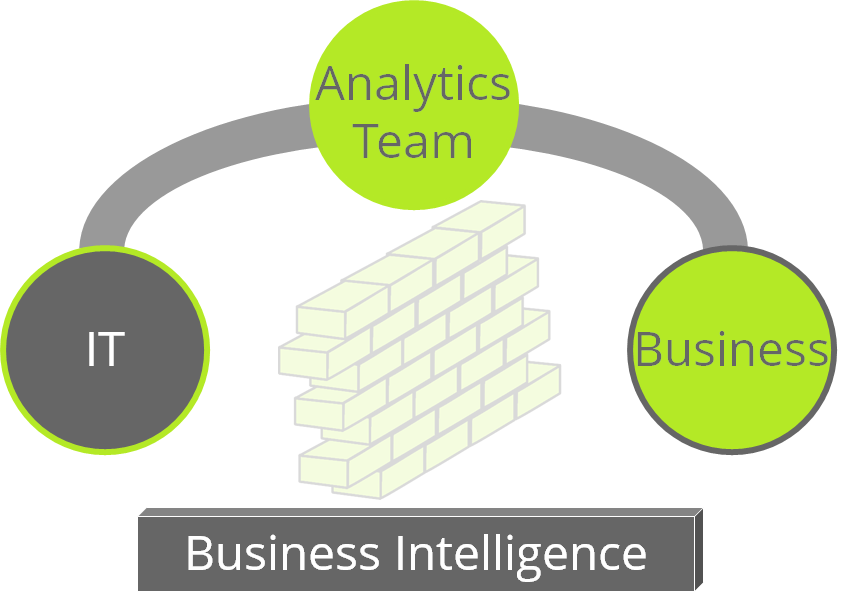
President Reagan in his famous “Tear down this wall” address, asked for the Berlin wall to be brought down. Believing that freedom and security go together. With the same sentiment, we make a call to tear down another wall.
Tear down the wall between IT and business, and bring Business Intelligence (BI) to everyone.
Note 1: IT and the Business team of course interface on many fronts, but for this article we would focus on Business Intelligence.
Note 2: The teams go by many different names. IT represents the central team, setup to meet the needs of the business user. Business User is the frontline personnel who have the need for BI, actionable data insights to run the business (could be Finance, Marketing, Executive Leadership team etc.)
I have spent time on both sides of this wall and will make some observations from my personal perspective. This is an amalgamation of the various Business/IT roles I held and not a specific role (in case my former colleagues are reading ![]() ). I realize I oversimplify and generalize a few points for the purpose of driving home the message.
). I realize I oversimplify and generalize a few points for the purpose of driving home the message.
Leave a comment and let us know how you have experienced the IT/Business divide yourself, pertaining to BI.

Business User
Majority of my career has been spent with one or the other business team. Here is my perspective on BI and IT’s role, based on that experience.
Low Opinion of IT: As a business user, to be blunt, I thought poorly of the central IT team. They didn’t seem to “get” my business requirements, and even if they did they were woefully slow to fulfill the request.
11 weeks: That’s the average time it takes to add a new column in an existing report
Guerilla BI: Therefore, I was largely left to fend for myself and resort to Guerilla BI. I would cobble together BI that I needed, using any means that I could. I would use a potpourri of technologies; largely reliant on Excel and it’s bag of tricks, but also heavy doses of SQL and a smattering of other tools (Tableau, Crystal, SSRS…).
Scalability Nightmares: I was actually really good at Guerilla BI, but that became part of the problem. I became a victim of my own success. My reports and spreadsheets gained in popularity and usage. But with that came the need to cater to a larger audience and increasing demands for changes/additions to reports.
Hero Syndrome: Even as the complexity grew, I could keep the system standing (barely at times) and be the hero. But, in spite of my best efforts at documenting and streamlining, a big part of my work died when I eventually left the role. It was too complex for someone else to step in and take it over. It just fell by the wayside.
IT (Central BI Team)
For this incarnation of mine, I was part of a central BI team. Whereas as a Business Analyst I was used to flying solo (when it came to BI); in this role I was working with a team. With a team, a certain “team dynamic” emerges. Here’s what it felt like to be part of the central BI Team:
Inundated by business requests: It was death by a thousand cuts. Many small requests would together make a mountain. We started with a clean slate, but soon had lists of items we would keep pushing out from one release to the next.
Doing a thankless job: Business users often think BI is “easy”. We were at times, told this to our faces. In fact, solving some of the BI problems at an organization level can be extremely challenging (ever tried to conform a Product table across various business groups while handling slowly changing dimensions?). It was hard to impress this upon business users who only viewed BI from their perspective.
Furthermore, with BI the bar constantly gets higher. It’s like running on a treadmill, you can never make the customer happy (for too long). In one instance, we changed the refresh lag from 2.5 months (yes, that’s right) to 1 day. What did we get in reward? Complaints about the few days when the daily refresh would fail.
Mistakes get magnified: With IT/Operations if things are running smoothly, people take little notice. But if one thing goes wrong, sh*t hits the fan. You are typically noticed, only when there is bad news.
Bias towards Inaction: Instead of moving as fast as you can, the focus becomes on stability and security. And the most stable system is one that never changes. Coupled with the previous factors, an inertia of rest settles in. You find yourself pushing back on changes rather then spearheading them.
Slow Spiral of Death
You can say that I had been in a messed up team as a Business or IT user. But I have seen this dynamic in a few different teams that I was part of. And witnessed the same tension between IT and Business, in the long list of engagements at P3 Adaptive .
It’s ironic that both BI efforts are doomed to fail. Both systems die a slow death: Guerilla BI primarily due to lack of scalability, and Corporate BI due to a lack of agility.

Both Corporate and Guerilla BI are doomed to a slow spiral of death
Which is a pity, since that results in business being run by the seat of the pants and gut-instincts rather than data-driven informed decisions. In the end it hurts the business which hurts all user groups.
Power BI Unites the World
I am usually wary of “technology” solutions, as all of us should be. In corporate America, you hear so many sales pitches of the form – just buy our tool and all your problems go away. But it rarely turns out that way. Same is the case with BI and the divide between IT and Business.
But I do believe that the tool has been the “missing link”. You can assemble the best team in the world, but there is little the team can accomplish without the right tools.

Which tool would you chose to dig?
You need a BI toolset that is capable but also agile and scalable. Power BI delivers on all fronts.
I will not claim that Power BI is the only such toolset in the marketplace. It is hard to separate fact from fiction in the contested word of BI. Many a toolset comes with lofty promises but fail to deliver. In that sense, I can claim that Power BI is the real deal. I’ve experienced the metamorphosis myself when adopting these tools for our business group within Microsoft. And since joining P3 Adaptive , I have catalyzed and witnessed many such transformations across various companies.
Power BI can bring both teams together – IT and Business, by empowering both communities.
Once You Have the Right Tool, It’s All About the People
Many BI tool decisions are made at the top. After polished pitches from various BI vendors, the executive, picks their favorite. What seems like a great decision at the time, usually gets nowhere in the long run.
Most BI initiatives, fail to show a positive return on investment.
The only success stories that I have seen have been built from the ground up not from the top down. As awesome as Power BI toolset is…beyond that, it’s still all about the people. You’ve overcome a hurdle by equipping your team with the right toolset. But you still need to enable them to run at top speed.
Your Power BI Team
The management needs to involve all parties, the IT teams as well as the business users. Start with basic training for all, so everyone can appreciate the power and strength of Power BI. The benefits of this training are twofold.
Diffuse the Resistance to Power BI: Change is hard, even the change for good. People are naturally inclined to resist change. By involving everyone, you’re reducing the likelihood of obstructionists and naysayers. Do message Power BI as a layer on Excel or Excel++ rather than a replacement (Read how that makes a big difference)
Data Gene People: Rob anecdotally states that 1 in 16 have the “data gene”. They may come from all corners of your business, welcome them all. Basic Power BI training can help you surface the “data gene” people to the forefront, as they latch on to the power of these tools.

1 in 16 people have the Data Gene, seek them out for your Power BI team
An ACE to Bridge the Divide
Traditionally the “BI” teams have been placed within the IT team. This is a poor choice. Business Intelligence belongs to the business. You’re better off placing the BI team within a business unit. Or, you have another choice. Set up the BI team as a “Bridge” team between IT and your business units.
Little more than an year ago, while still at Microsoft, I heard a powerful BI transformation story. Seth Brickman used Power BI (in the shape that it existed back then: SSAS Tabular + SharePoint) to turn around BI for Holland America Cruise Line. There is a [link removed due to 404] case study you can read, but I was lucky to hear Seth talk about his journey in-person at a local meetup.
One part that appealed to me, was how he described his team was setup and it’s name. They had a kick-ass name – ACE: Analytics Center of Excellence. And they were setup as a bridge between IT and the business.

Analytics Team can help bridge the divide between IT and Business Units
Consider forming an ACE team of your own, with your data gene people. The ACE team would speak both languages, business and technical. The ACE team also needs to have the blessings of senior management and be empowered to act.
Time to Tear Down the Wall
The Berlin wall stood for 28 years and artificially divided populace of a centuries old city. In the years following Reagan’s speech it became increasingly inevitable that the Berlin wall would come down. It was an anachronism no longer suited for the new world. I say the same is true for the wall between IT and Business. The time has come, with tools like Power BI, for us to strike at the wall and see it crumble.
After which you would see, there is no real divide between IT and the Business user. An IT person is as invested in helping the business grow as a business user. And a business user can work shoulder to shoulder with an IT person in building their BI infrastructure.
Power On!